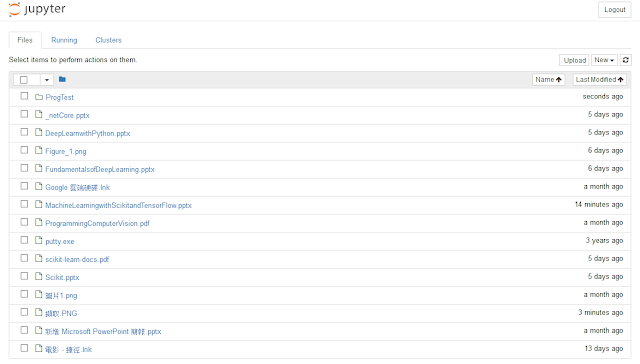TensorFlow (4-3) CNN of MNIST
1. Recall the process of CNN:
在 4-1 我們討論過 CNN 的流程, CNN 的流程如下圖所示:

- 輸入圖片
- 捲積然後用 relu 輸出響應
- 池化 (選擇較重要的資訊)
- 重複 2 和 3
- 扁平化並連接神經元
- softmax 輸出機率
今天我們要參照這個流程實做 MNIST 的 CNN。
2. CNN Wrapper functions:
定義一些包裝過的函式,這樣在計算時可以提高可讀性,前篇有說明過 max_pool 和 conv2d 的用法。
#!/usr/bin/python3
import tensorflow as tf
import numpy as np
from tensorflow.examples.tutorials.mnist import input_data
def weight_variable(shape):
initial = tf.truncated_normal(shape, stddev=0.1)
return tf.Variable(initial)
def bias_variable(shape):
initial = tf.constant(0.1, shape=shape)
return tf.Variable(initial)
def conv2d(x, W):
return tf.nn.conv2d(x, W, strides=[1, 1, 1, 1], padding='SAME')
def max_pool_2x2(x):
return tf.nn.max_pool(x, ksize=[1, 2, 2, 1],
strides=[1, 2, 2, 1], padding='SAME')
def conv_layer(input, shape):
W = weight_variable(shape)
b = bias_variable([shape[3]])
return tf.nn.relu(conv2d(input, W) + b)
def full_layer(input, size):
in_size = int(input.get_shape()[1])
W = weight_variable([in_size, size])
b = bias_variable([size])
return tf.matmul(input, W) + b
最重要是後面三個函式,我們會重複捲積和池化然後輸出到 full layer。
3. main process:
我們把整個計算分成三部份 computational_process, computational_targets and train:
1. computational_process: x 接收數筆 MNIST 資料,x_image 會把 MNIST 變成 28*28 的正方形圖片,以便之後的捲積。 第一層捲積的 filter 矩陣維度為 5*5*1*32,也就是 32 個 5*5*1 (H*W*D) 的 filter。 因為我們使用 padding='SAME' 模式,經過第一次捲積後輸出的維度為 -1*28*28*32,再經過 max_pool_2x2 運算後後維度為 -1*14*14*32。 第二層捲積的 filter 矩陣為 5*5*32*64,也就是 64 個 5*5*32 (H*W*D) 的 filter,經過 conv_layer 和 max_pool_2x2 運算後後維度為 -1*7*7*64。最後再連接到大小為 1024 的 full layer 上。

2. computational_tagets: 這邊和一般的神經網路差不多,定義了精準度和誤差。比較特別的是這邊選用 AdamOptimizer。
3. train: 訓練也和之前差不多,不過我們為了加速 CNN 的運行定義了 KEEP_PROB 這個參數。KEEP_PROB 是用來避免 over fitting,假設你的 entropy 刪減掉一些神經元時結果仍然差不多,我們就可以考慮丟棄一些神經元。
if __name__== "__main__":
with tf.name_scope("computational_process"):
x = tf.placeholder(tf.float32, shape=[None, 784])
y_true = tf.placeholder(tf.float32, shape=[None, 10])
x_image = tf.reshape(x, [-1, 28, 28, 1])
conv1 = conv_layer(x_image, shape=[5, 5, 1, 32])
conv1_pool = max_pool_2x2(conv1)
conv2 = conv_layer(conv1_pool, shape=[5, 5, 32, 64])
conv2_pool = max_pool_2x2(conv2)
conv2_flat = tf.reshape(conv2_pool, [-1, 7*7*64])
full_1 = tf.nn.relu(full_layer(conv2_flat, 1024))
keep_prob = tf.placeholder(tf.float32)
full1_drop = tf.nn.dropout(full_1, keep_prob=keep_prob)
y_conv = full_layer(full1_drop, 10)
with tf.name_scope("computational_targets"):
DATA_DIR = "data"
mnist = input_data.read_data_sets(DATA_DIR, one_hot=True)
cross_entropy = tf.reduce_mean(tf.nn.softmax_cross_entropy_with_logits_v2(labels=y_true, logits=y_conv))
train_step = tf.train.AdamOptimizer(1e-4).minimize(cross_entropy)
correct_prediction = tf.equal(tf.argmax(y_conv, 1), tf.argmax(y_true, 1))
accuracy = tf.reduce_mean(tf.cast(correct_prediction, tf.float32))
with tf.name_scope("train"):
STEPS = 300
BATCH_SIZE = 50
KEEP_PROB = 0.8
with tf.Session() as sess:
sess.run(tf.global_variables_initializer())
for i in range(STEPS):
batch = mnist.train.next_batch(BATCH_SIZE)
sess.run(train_step, feed_dict={x: batch[0], y_true: batch[1], keep_prob: KEEP_PROB})
if i % 30 == 0:
train_accuracy = sess.run(accuracy,
feed_dict={x: batch[0],
y_true: batch[1],
keep_prob: 1.0})
print("step {}, training accuracy {}".format(i, train_accuracy))
X = mnist.test.images.reshape(10, 1000, 784)
Y = mnist.test.labels.reshape(10, 1000, 10)
test_accuracy = np.mean([sess.run(accuracy,
feed_dict={x:X[i], y_true:Y[i], keep_prob:1.0})
for i in range(10)])
print ("test accuracy: {}".format(test_accuracy))
Reference
[1] Tom Hope, Yehezkel S. Resheff, and Itay Lieder, Learning TensorFlow A Guide to Building Deep Learning Systems , O'Reilly Media (2017)
[2] Nikhil Buduma, Fundamentals of Deep Learning Designing Next-Generation Machine Intelligence Algorithms, O'Reilly Media (2017)
[3] Aurélien Géron, Hands-On Machine Learning with Scikit-Learn and TensorFlow Concepts, Tools, and Techniques to Build Intelligent Systems , O'Reilly Media (2017)

留言
張貼留言